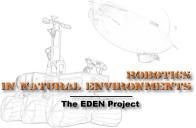A blimp: first step towards air/ground cooperative robotics
Our long term objectives in field robotics is to tackle the various
issues raised by the deployment of heterogeneous autonomous systems, in
the context of exploration, surveillance and intervention
missions. Within such contexts, aerial robots will undoubtly play a
growing role in the near future, not only during the mission preparation
phase (in which drones can already gather environment informations for
instance), but also on-line, during the mission execution. Aerial robots
can then provide the rovers with telecommunications support, as well as
with up-to-date informations on the environment. They can also localize
the rovers as they evolve within this environment, and even achieve by
themselves some of the mission goals.
Why a blimp ?
We recently initiated the development of an autonomous blimp. We are
convinced that the ever on-going developments in a wide spectrum of
technologies, ranging from actuator, sensors and computing devices to
energy and material will ensure lighter than air machines a promising
future. There is undoubtly a regain of interest in this domain, as shown
by the recent industrial developments on heavy loads transportation
projects (such as CargoLifter and the ATG Skycats, not to mention
various other prospective transportation projects), and on stratospheric
telecommunication platforms.
As for small-size unmanned radio-controlled models, which size is of the
order of a few tens of cubic meters, their domain of operation is
currently essentially restrained to advertising or aerial
photography. But their properties makes them an very suitable support to
develop heterogeneous air/ground robotics systems: they are easy to
operate, they can safely fly at very low altitudes (down to a few
meters), and especially their dynamics is comparable with the ground
rovers dynamics, as they can hover a long time over a particular area,
while being able to fly at several tens of kilometers per hour, still
consuming little energy. Their main and sole enemy is the wind. Some
specific applications of unmanned blimps are more and more seriously
considered throughout the world, from planetary exploration to military
applications, as shown by numerous contributions in the AIAA Lighter
Than Air conferences or the Airship Conventions for instance.
Our work
Besides long-term developments related to the coordination and cooperation
of heterogeneous air/ground robots, our research work on autonomous blimps
is currently twofold [Lacroix 2000, Lacroix 2002b, Hygounenc 2003]:
- Flight control
Our objective is to endow a blimp with the possibility to servo its
trajectories on the basis of its state sensors, and in the long term
on the basis of the perception of ground elements with cameras.
- Environment mapping
Mapping the environment with images acquired from the blimp is an
important issue: it can be the blimp mission, it will be required to
define trajectories servoed on the overflown environment, and will
also be the basis upon air/ground cooperation scenarios can be
achieved.
To study, develop and experimentally validate the work on these issues,
we acquired in the end of 2001 a 15 m³ airship, and defined
the necessary on-board equipment.
The first mentions of the development of unmanned autonomous blimps can
be found in the literature of the late 80's, but it's only recently that
various projects have reached effective achievements:
- The Aurora project
held at the Information Technology Institute of Campinas, Brazil,
mainly devoted to flight control. Some informations can be found here, and various
publications parreared in the main airship and robotics conferences.
- Lotte
at the University od Stuttgart, very interesting developments on the
development of a solar airship. Model identification and flight
control are also considered issues.
Other unmanned airship projects are considered in the University of
Virginia (Aztec), in the York University, in the Aberystwyth
University...
Worth to mention are some web sites that gathers a lot of information on
airships (e.g. Airship and Blimp
Resources or Les
dirigeables - in french)
|
[Lacroix 2002b]
| [related pages] [abstract] [download] [BibTeX] [top] |
|
S. Lacroix, I-K. Jung, P. Soueres, E. Hygounenc and J-P. Berry. The autonomous blimp project of LAAS/CNRS: Current status
and research challenges. In 8th International Symposium on Experimental Robotics. Sant'Angelo d'Ischia (Italy), 2002.
|
|
[Hygounenc 2003]
| [related pages] [abstract] [download] [BibTeX] [top] |
|
E. Hygounenc, I-K. Jung, P. Soueres and S. Lacroix. The autonomous blimp project at LAAS/CNRS: achievements in
flight control and terrain mapping. In to appear in International Journal of Robotics Research, 2003.
|
| |
General Information
Robots
Rovers Navigation
Autonomous Blimps
Multi-Robot Cooperation
|

